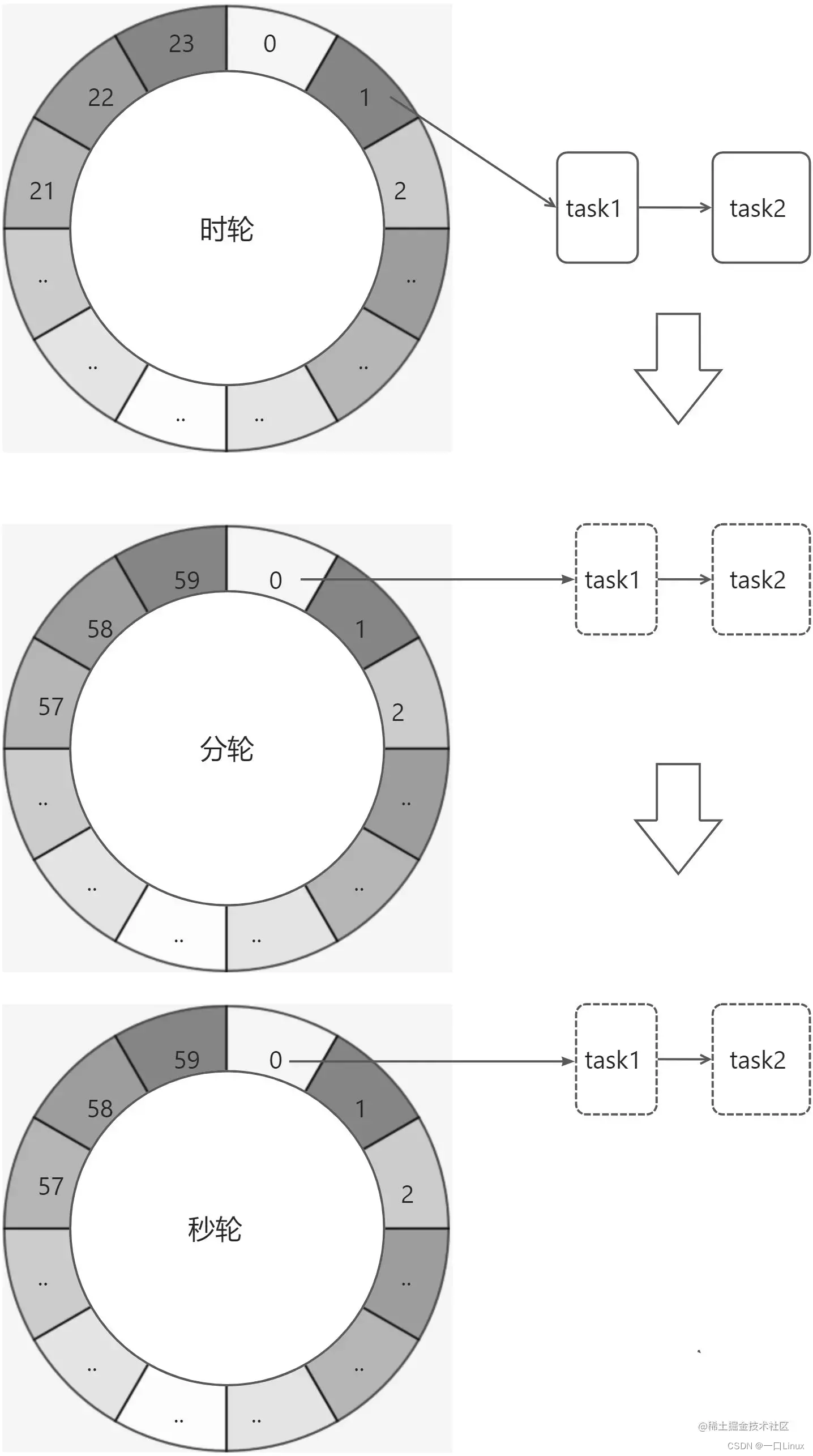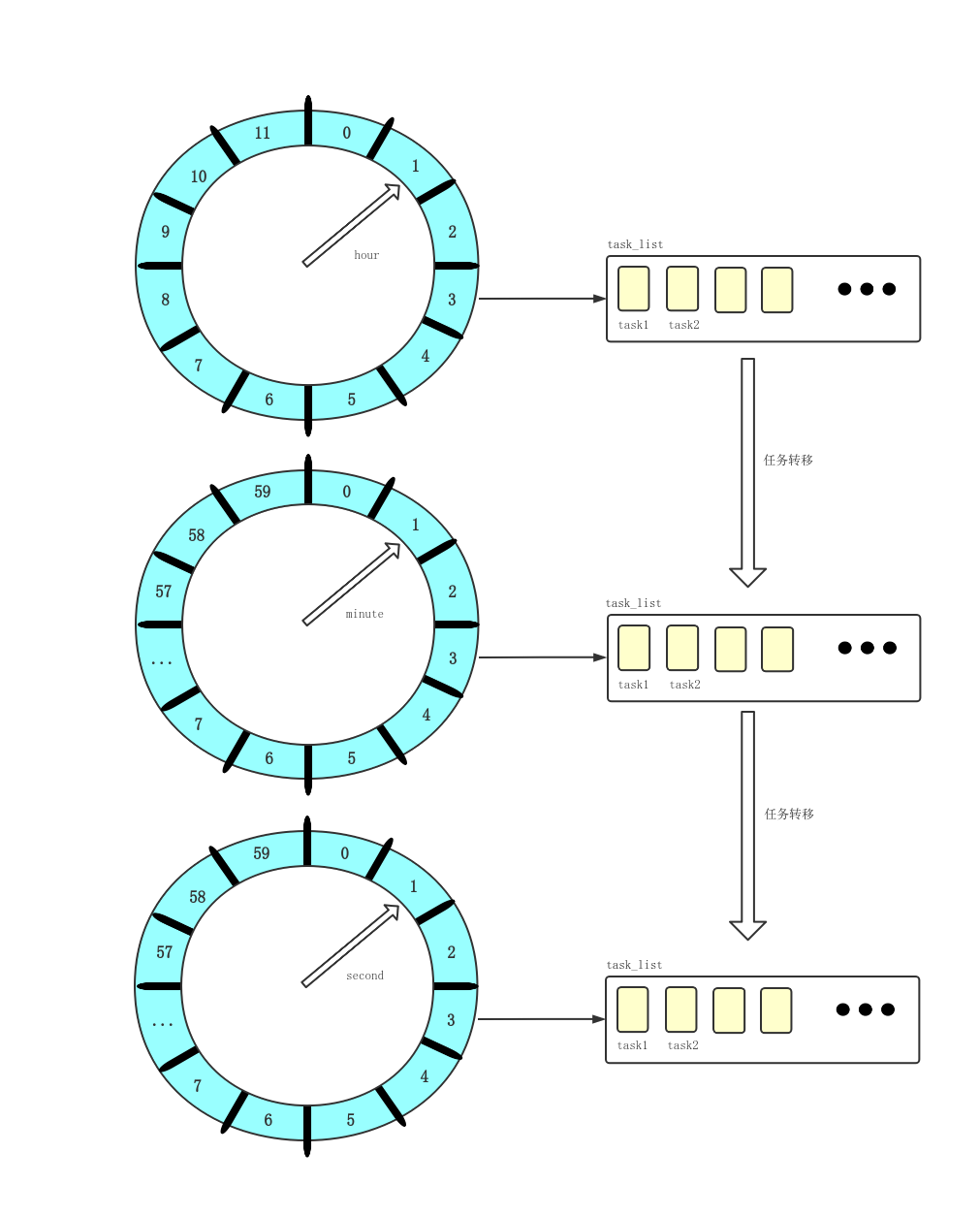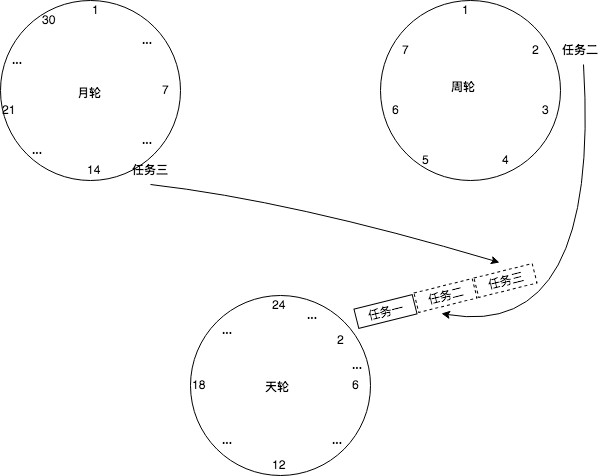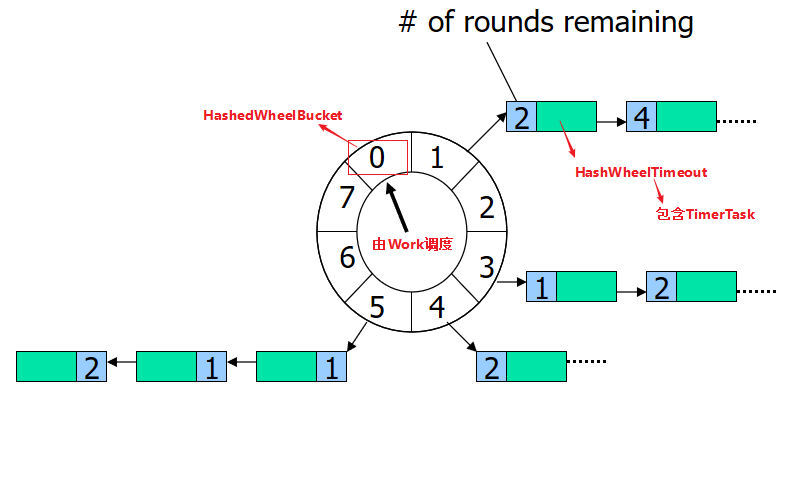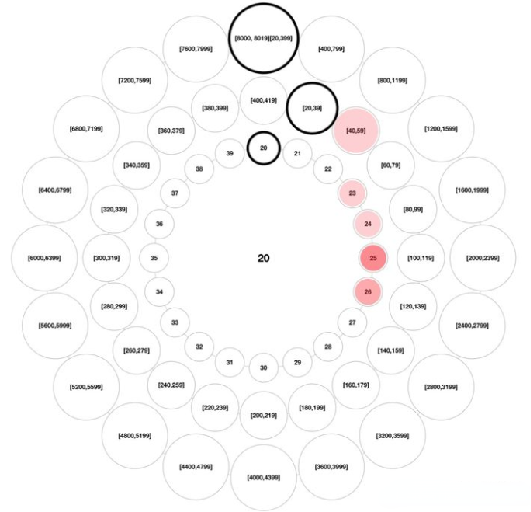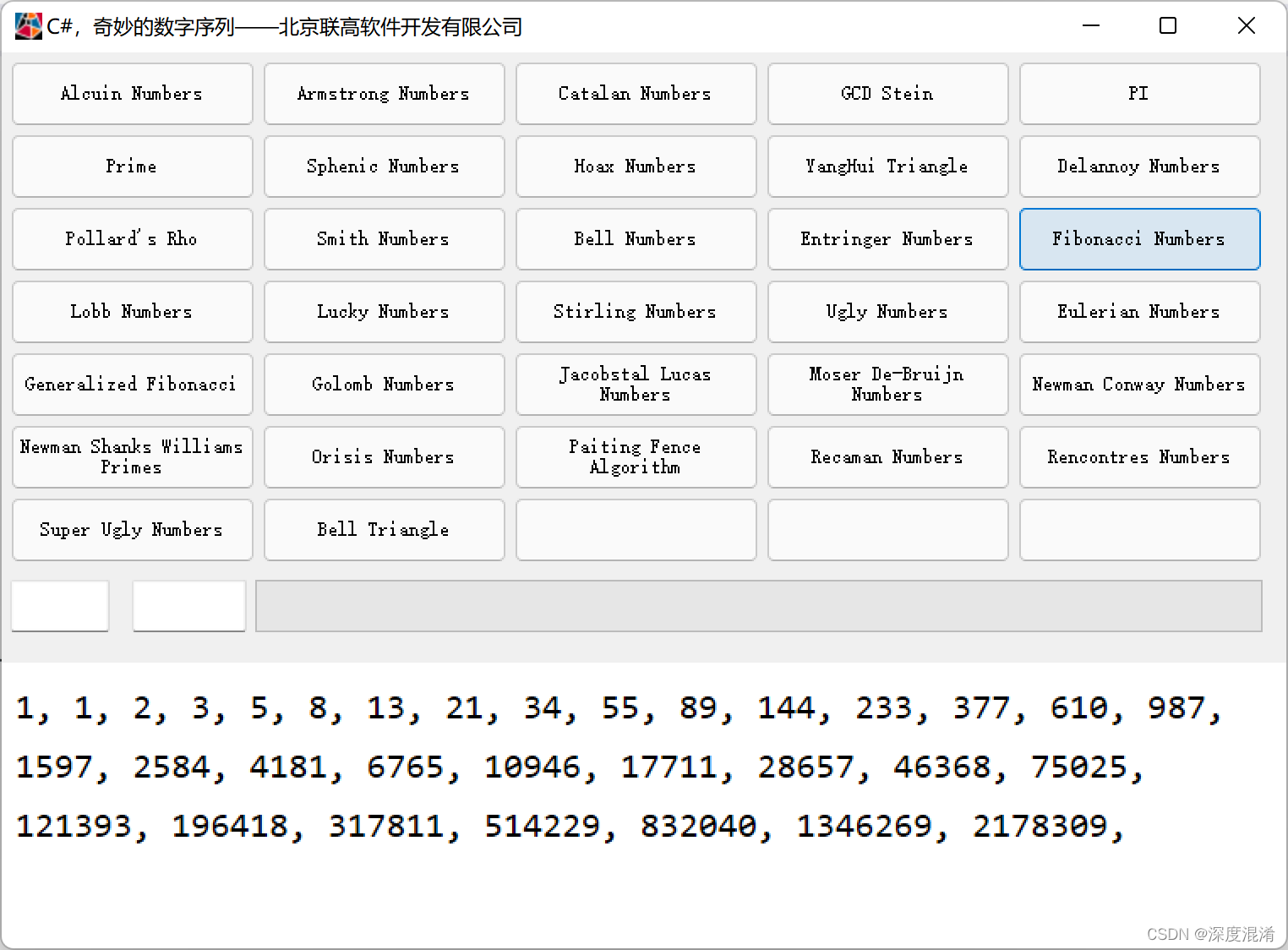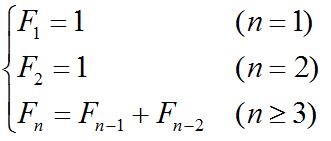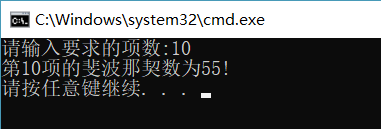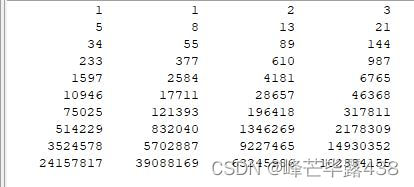文章目录
- 前言
- 时间轮定时使用方式
- 时间轮定时内部原理
- 时间轮定时源码剖析
- 构造方法
- 添加任务
- 工作线程启动
- 工作线程run方法
- 指针跳动
- 将队列任务放入时间轮中
- 链表任务遍历
- 定时任务执行
前言
最近在思考实现定时任务的几种方式,比如
quartz,delay queue,scheduleThreadPool,时间轮。在对比的同时,也了解了下其简单原理,在这里描述下我对时间轮算法实现定时任务的理解。
时间轮定时使用方式
@Testpublic void test3() throws InterruptedException {DateTimeFormatter formatter = DateTimeFormatter.ofPattern("yyyy-MM-dd HH:mm:ss");HashedWheelTimer timer = new HashedWheelTimer(new NamedThreadFactory("timer-task"), 1, TimeUnit.MILLISECONDS,8);TimerTask timerTask = new TimerTask() {@Overridepublic void run(Timeout timeout) throws Exception {System.out.println("hello world " + LocalDateTime.now().format(formatter));//执行完成之后再次加入调度timer.newTimeout(this, 4, TimeUnit.SECONDS);}};//将定时任务放入时间轮timer.newTimeout(timerTask, 4, TimeUnit.SECONDS);Thread.currentThread().join();}
在这里我使用的是 netty 使用时间轮算法实现的HashedWheelTimer来做的每隔 4s 的定时调度。
public HashedWheelTimer(ThreadFactory threadFactory,long tickDuration, TimeUnit unit, int ticksPerWheel)
使用方式比较简单,创建一个HashedWheelTimer时间轮定时器对象,threadFactory:创建线程的线程工厂
tickDuration:一个间隔时间(步长)
tickDuration:间隔时间的单位
ticksPerWheel:时间轮的大小
最后执行结果为:
hello world 2021-04-12 19:25:37
hello world 2021-04-12 19:25:41
hello world 2021-04-12 19:25:45
hello world 2021-04-12 19:25:49
hello world 2021-04-12 19:25:53
hello world 2021-04-12 19:25:57
hello world 2021-04-12 19:26:01时间轮定时内部原理
时间轮定时器原理基本都是如下图:
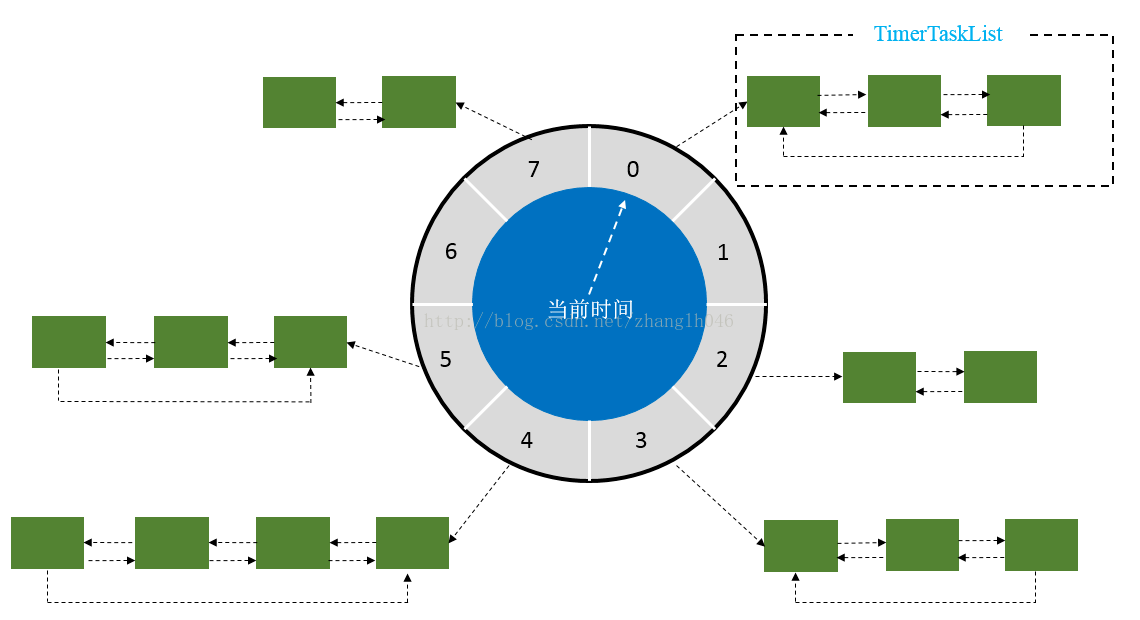
时间轮算法可以简单的看成一个循环数组+双向链表的数据结构实现的。
循环数组构成一个环形结构,指针每隔 tickDuration 时间走一步,每个数组上挂载一个双向链表结构的定时任务列表。
双向链表上的任务有个属性为 remainingRounds,即当前任务剩下的轮次是多少,每当指针走到该任务的位置时,remainingRounds 减 1,直到remainingRounds 为 0 时,定时任务触发。
通过时间轮算法的原理图我们可以知道,tickDuration 越小,定时任务越精确。
时间轮定时源码剖析
构造方法
首先从 HashedWheelTimer 的构造方法分析
public HashedWheelTimer(ThreadFactory threadFactory,long tickDuration, TimeUnit unit, int ticksPerWheel, boolean leakDetection,long maxPendingTimeouts) {//线程工厂非null判断if (threadFactory == null) {throw new NullPointerException("threadFactory");}//时间单位非null判断if (unit == null) {throw new NullPointerException("unit");}//时间间隔(步长)大于0判断if (tickDuration <= 0) {throw new IllegalArgumentException("tickDuration must be greater than 0: " + tickDuration);}//循环数组长度大于0判断if (ticksPerWheel <= 0) {throw new IllegalArgumentException("ticksPerWheel must be greater than 0: " + ticksPerWheel);}// Normalize ticksPerWheel to power of two and initialize the wheel.// 将ticksPerWheel修改为2的整数次幂 并且新建数组wheel = createWheel(ticksPerWheel);// 数组长度-1,其二进制均为1. 通过指针tick&mask 获取当前的数组下标,类似于hashmap的 hashcode&(len -1)mask = wheel.length - 1;// Convert tickDuration to nanos.long duration = unit.toNanos(tickDuration);// Prevent overflow.if (duration >= Long.MAX_VALUE / wheel.length) {throw new IllegalArgumentException(String.format("tickDuration: %d (expected: 0 < tickDuration in nanos < %d",tickDuration, Long.MAX_VALUE / wheel.length));}if (duration < MILLISECOND_NANOS) {if (logger.isWarnEnabled()) {logger.warn("Configured tickDuration %d smaller then %d, using 1ms.",tickDuration, MILLISECOND_NANOS);}this.tickDuration = MILLISECOND_NANOS;} else {this.tickDuration = duration;}//创建工作线程,该线程会定期的移动指针,扫描链表任务,后面再分析workerThread = threadFactory.newThread(worker);leak = leakDetection || !workerThread.isDaemon() ? leakDetector.track(this) : null;this.maxPendingTimeouts = maxPendingTimeouts;//判断HashedWheelTimer实例是否创建太多,如果是就输出一个日志if (INSTANCE_COUNTER.incrementAndGet() > INSTANCE_COUNT_LIMIT &&WARNED_TOO_MANY_INSTANCES.compareAndSet(false, true)) {reportTooManyInstances();}}
构造方法比较简单明了,主要是做一些初始化工作,比如数组的长度控制为2的整数次幂,新建数组,新建工作线程等。
添加任务
继续往下看如何向时间轮定时器添加一个定时任务。
@Overridepublic Timeout newTimeout(TimerTask task, long delay, TimeUnit unit) {if (task == null) {throw new NullPointerException("task");}if (unit == null) {throw new NullPointerException("unit");}//一个计数器,表示当前在队列中等待的任务数量long pendingTimeoutsCount = pendingTimeouts.incrementAndGet();//默认maxPendingTimeouts为-1,如果该值>0.添加新任务时会进行判断,如果当前任务大于maxPendingTimeouts,则跑出拒绝异常if (maxPendingTimeouts > 0 && pendingTimeoutsCount > maxPendingTimeouts) {pendingTimeouts.decrementAndGet();throw new RejectedExecutionException("Number of pending timeouts ("+ pendingTimeoutsCount + ") is greater than or equal to maximum allowed pending "+ "timeouts (" + maxPendingTimeouts + ")");}//检测工作线程扫描是否启动,如果未启动,启动下start();// Add the timeout to the timeout queue which will be processed on the next tick.// During processing all the queued HashedWheelTimeouts will be added to the correct HashedWheelBucket.//startTime为工作线程启动的时间,deadline为:System.nanoTime()+任务延迟时间-工作线程的启动时间long deadline = System.nanoTime() + unit.toNanos(delay) - startTime;// Guard against overflow.//溢出判断,因为startTime是在start()方法中启动工作线程后赋值的,在delay大于0的情况下,deadline是不可能小于0,除非溢出了。如果溢出了为deadline赋值一个最大值if (delay > 0 && deadline < 0) {deadline = Long.MAX_VALUE;}//创建HashedWheelTimeout对象HashedWheelTimeout timeout = new HashedWheelTimeout(this, task, deadline);//将任务加入timeouts队列timeouts.add(timeout);return timeout;}
该方法主要执行以下几个工作
1.参数非空校验
2.任务数量最大值检测
3.工作线程启动
4.获取任务的 deadline,将任务封装为 HashedWheelTimeout 对象
5.将 HashedWheelTimeout 对象放入任务队列 timeouts
工作线程启动
下面简单看下 start 方法
public void start() {switch (WORKER_STATE_UPDATER.get(this)) {case WORKER_STATE_INIT:if (WORKER_STATE_UPDATER.compareAndSet(this, WORKER_STATE_INIT, WORKER_STATE_STARTED)) {//如果发现当前工作线程的状态为WORKER_STATE_INIT 初始化状态,则设置线程状态为 WORKER_STATE_STARTED并 启动工作线程,workerThread.start();}break;case WORKER_STATE_STARTED:break;case WORKER_STATE_SHUTDOWN:throw new IllegalStateException("cannot be started once stopped");default:throw new Error("Invalid WorkerState");}// Wait until the startTime is initialized by the worker.//startTime 初始值为0,并且在工作线程启动后设置。startTimeInitialized是一个CountDownLatch锁,在工作线程启动后释放while (startTime == 0) {try {startTimeInitialized.await();} catch (InterruptedException ignore) {// Ignore - it will be ready very soon.}}}
该方法主要是启动工作线程并等待工作线程启动完成。
继续看工作线程的 run 方法做什么事情
工作线程run方法
public void run() {// Initialize the startTime.//线程启动后初始化startTime 时间为System.nanoTime()startTime = System.nanoTime();if (startTime == 0) {// We use 0 as an indicator for the uninitialized value here, so make sure it's not 0 when initialized.startTime = 1;}// Notify the other threads waiting for the initialization at start().//释放start方法中的CountDownLatch锁startTimeInitialized.countDown();//在当前工作线程状态一直为 WORKER_STATE_STARTED 时循环执行do {//waitForNextTick 主要是指针跳动,内部使用Thread.sleep实现final long deadline = waitForNextTick();//小于0表示收到了关闭的信号if (deadline > 0) {//tick和mask进行按位与操作获取到当前数组下标位置int idx = (int) (tick & mask);//从时间轮中移除所有已经取消的定时任务processCancelledTasks();//获取到下标对应的链表头HashedWheelBucket bucket =wheel[idx];//将队列中的定时任务放入到时间轮中transferTimeoutsToBuckets();//遍历链表任务,将达到执行时间的任务触发执行bucket.expireTimeouts(deadline);//指针+1tick++;}} while (WORKER_STATE_UPDATER.get(HashedWheelTimer.this) == WORKER_STATE_STARTED);// Fill the unprocessedTimeouts so we can return them from stop() method.//工作线程停止后,将时间轮上的所有任务放入unprocessedTimeouts集合for (HashedWheelBucket bucket: wheel) {bucket.clearTimeouts(unprocessedTimeouts);}//将任务队列中的任务也放入unprocessedTimeouts集合for (;;) {HashedWheelTimeout timeout = timeouts.poll();if (timeout == null) {break;}if (!timeout.isCancelled()) {unprocessedTimeouts.add(timeout);}}//移除所有的未处理的定时任务processCancelledTasks();}
该部分代码主要分为以下几个部分
-
设置线程的启动时间
startTime -
在工作线程启动的状态下
- 根据用户配置的
tickDuration指针每次跳动一下 - 从时间轮中移除所有已经取消的定时任务
- 将队列中的定时任务放入到时间轮中
- 遍历链表任务,将达到执行时间的任务触发执行
- 根据用户配置的
-
工作线程停止后的清理工作
下面看一下指针跳动的代码
指针跳动
private long waitForNextTick() {//获取下一个指针的deadline时间long deadline = tickDuration * (tick + 1);for (;;) {//当前工作线程的活动时间final long currentTime = System.nanoTime() - startTime;//计算还需要多久达到deadline 。这里加上999999的原因是因为/只会取整数部分,并且是使用Thread.sleep时间的,参数为毫秒。为了保证任务不被提前执行,加上999999后就能够向上取整1ms。long sleepTimeMs = (deadline - currentTime + 999999) / 1000000;//sleepTimeMs 小于0表示达到了任务的触发时间if (sleepTimeMs <= 0) {if (currentTime == Long.MIN_VALUE) {return -Long.MAX_VALUE;} else {return currentTime;}}// Check if we run on windows, as if thats the case we will need// to round the sleepTime as workaround for a bug that only affect// the JVM if it runs on windows.//// See https://github.com/netty/netty/issues/356if (PlatformDependent.isWindows()) {sleepTimeMs = sleepTimeMs / 10 * 10;}try {Thread.sleep(sleepTimeMs);} catch (InterruptedException ignored) {if (WORKER_STATE_UPDATER.get(HashedWheelTimer.this) == WORKER_STATE_SHUTDOWN) {return Long.MIN_VALUE;}}}}
通过源码分析我们可以看到时间轮算法实现的指针跳动是通过Thread.sleep 实现的,难以理解的就是 (deadline - currentTime + 999999) / 1000000; 仔细研究下就懂了
将队列任务放入时间轮中
在工作线程的 run 方法中会调用 transferTimeoutsToBuckets方法,该方法会将用户提交到队列中的定时任务移动到时间轮中,下面具体分析下
private void transferTimeoutsToBuckets() {// transfer only max. 100000 timeouts per tick to prevent a thread to stale the workerThread when it just// adds new timeouts in a loop.//每次最多只迁移 10W 个定时任务,主要是为了防止迁移时间过长,导致时间轮中的任务延迟执行for (int i = 0; i < 100000; i++) {HashedWheelTimeout timeout = timeouts.poll();if (timeout == null) {// all processedbreak;}//如果任务已经被取消,就跳过if (timeout.state() == HashedWheelTimeout.ST_CANCELLED) {// Was cancelled in the meantime.continue;}//计算任务需要放入的数组位置long calculated = timeout.deadline / tickDuration;//由于时间轮中的数组是循环数组,计算还需要几个轮次timeout.remainingRounds = (calculated - tick) / wheel.length;//calculated 和tick 取最大,主要是为了保证过时的任务能够被调度。正常情况下calculated是大于tick的,如果某些任务执行时间过长,导致tick大于calculated,此时直接把过时的任务放到当前链表队列final long ticks = Math.max(calculated, tick); // Ensure we don't schedule for past.//按位与获取任务的执行位置int stopIndex = (int) (ticks & mask);HashedWheelBucket bucket = wheel[stopIndex];//将任务放入当前数组上的链表bucket.addTimeout(timeout);}}
transferTimeoutsToBuckets 方法很简单,我们主要要记住两点
1.每次最多会迁移10W 个队列中的任务到时间轮中,为了保证不影响工作线程的指针跳动
2.并且我们发现取消的任务会直接跳过,过时的任务会直接放到当前位置。
链表任务遍历
public void expireTimeouts(long deadline) {HashedWheelTimeout timeout = head;// process all timeouts//遍历链表的所有任务while (timeout != null) {HashedWheelTimeout next = timeout.next;//如果剩下的轮次<=0if (timeout.remainingRounds <= 0) {//从双向链表中移除该任务next = remove(timeout);//如果当前任务的deadline小于目前时间轮的deadline,表示任务已经可以被触发if (timeout.deadline <= deadline) {//任务执行timeout.expire();} else {// The timeout was placed into a wrong slot. This should never happen.throw new IllegalStateException(String.format("timeout.deadline (%d) > deadline (%d)", timeout.deadline, deadline));}} else if (timeout.isCancelled()) {//任务取消也从链表中移除next = remove(timeout);} else {// 任务的剩余轮次-1timeout.remainingRounds --;}//链表遍历timeout = next;}}
该方法主要是遍历链表上的定时任务
- 任务所剩轮次为
0并且任务的deadline小于目前时间轮的deadline,任务触发执行 - 任务被取消,从链表中移除
- 任务轮次大于
0并且还未取消,轮次-1 - 遍历下个定时任务
定时任务执行
public void expire() {if (!compareAndSetState(ST_INIT, ST_EXPIRED)) {return;}try {task.run(this);} catch (Throwable t) {if (logger.isWarnEnabled()) {logger.warn("An exception was thrown by " + TimerTask.class.getSimpleName() + '.', t);}}}
定时任务执行代码,看着很简单,首先将任务的状态设置为ST_EXPIRED,然后直接调用 run方法执行任务,这里说明任务是在工作线程中执行的,也就是说如果任务执行时间过长,会影响其它定时任务的触发。


